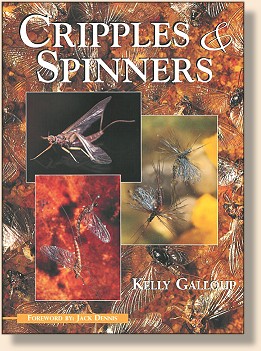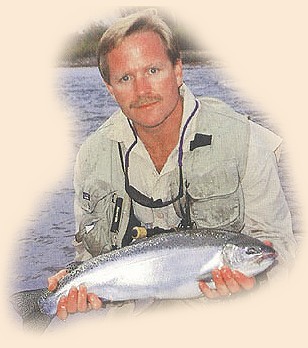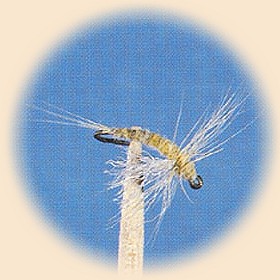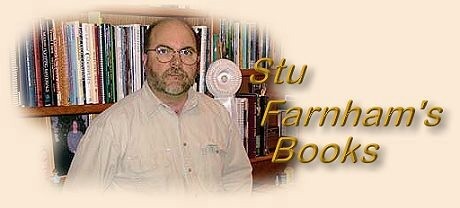|
The Internet is a powerful resource. It provides us instant
access to information, and brings us together via email,
bulletin boards, chat rooms, and instant messaging. FAOL
is a wonderful example of the Internet at its best. The Internet,
however, will never replace the printed page.
I've loved books and fishing since my youngest years, although
I did not start fly fishing until 1993. This column will give
me an opportunity to share reviews of some of my favorite fly
fishing and tying books (and some that are not such favorites)
with my friends here at FAOL. My library reflects my tastes
and interests, and so will this column. It will be heavily
slanted towards cold water fishing and tying for trout and
steelhead, and won't touch much on areas of which I know little,
such as warm or salt water fishing.
I hope that these reviews will motivate some of you to pick up
a good book, on this or any subject, and read.
~ Stu Farnham
Cripples and Spinners
 Cripples and Spinners
Cripples and Spinners
by Kelly Galloup
Hardcover: 160 pages
Publisher: Dean Publishing, Traverse City, MI
$34.95 Hardcover
ISBN: 0970721307; (March 2001)
Scott Richmond, in his excellent little book The Pocket Gillie
(hmmm, a good subject for a later review), talks about patterns
and presentations that imitate aquatic insects at their points
of vulnerability (POV). POVs are those times at which the insect
is particularly vulnerable as prey for the trout, and the cripple
and spinner POVs have received relatively little attention until
recently.
Along with Bob Linsenman, Kelly wrote the 1999 book Modern
Streamers for Trophy Trout, which provided a comprehensive
look at tackle, flies, and techniques for streamer fishing. In
Cripples and Spinners, Galloup provides an equally
thorough coverage of his material.
Kelly opens the book with a survey of the scant literature on his
topic, and a review of the lifecycles of aquatic insects. In his
chapter 'The Significance of Spinners,' Galloup asserts that
spinners are important because they concentrate a large number
of vulnerable insects in a small area. He also disputes the
commonly held assertion that spinners provide little nutritional
value based on his observation that trout key in on females which
carry additional nutrition in the remains of the egg sac.
I suspect that most of us will remember Kelly's knocked-down dun
and cripple patterns as his most important contribution (see the
accompanying photo of his PMD cripple). He ties these patterns
on hooks with shanks bent to the side (as viewed from above).
The chapter on cripples includes good B&W photographs of crippled
mayflies as well as Galloup's excellent patterns to match them.
 Chapters on technique, equipment, and reading the water offer
little that is new. However, the chapter 'Rigging for Cripples
and Spinners' has excellent advice on pattern selection and
offers a number of two-fly rigs along with guidance on when
to use each rig.
Chapters on technique, equipment, and reading the water offer
little that is new. However, the chapter 'Rigging for Cripples
and Spinners' has excellent advice on pattern selection and
offers a number of two-fly rigs along with guidance on when
to use each rig.
The fly tying section yields the real meat of the book. Galloup
presents his philosophy of pattern design, covering shape and
dimension, color, and visibility. He also provides the obvious
but important observation that ". . .float is the number one
consideration in all [dry] fly design. You can have everything
on the fly exactly right. . .but if the fly does not ride properly
on the water all your efforts are in vain." He goes on to point
out that this means more than just sitting upright. The pattern
needs to sit in the water in the intended manner. Having just
gone through a series of experiments to adapt some existing
Pteronarcys patterns, I can attest to the validity of
these observations.
A separate chapter reviews Kelly's preferences in techniques
and materials as applied to cripples and spinners. In chapter
ten, Galloup profiles a number of leading contemporary tiers
from the US, and provides their thoughts on fly design,
especially as applied to the book's subject. He interviews
Andy Burk, Dave Ellis, Ted Fauceglia, Craig Matthews, Mike
Mercer, Gordon Rose, and Scott Sanchez.

There follows a section of excellent color photographs of
flies by each of the profiled tiers, as well as Galloup's
own patterns, and equally clear photos of naturals. Fly
recipes follow the photographs.
Cripples and Spinners was my favorite new
technical book on fly fishing and tying of 2001 (as opposed
to books of essays or fiction). This book may be hard to
find, as it was published by a small local press in Traverse
City, Michigan. You can find it on Amazon.com or for an
autographed copy contact Kelly at his new venture, (resort
and fly shop, the Slide Inn), between Ennis and West
Yellowstone, Montana.
Kelly Galloup
50 US HWY 287 S
Cameron MT 59720
Phone 406-682-4804
~ Stu Farnham
About Stu
 Stu Farnham is a New Englander by birth, who was transplanted to
and put down roots in Oregon in the early 1990s. A software
engineering manager by vocation, he can be found in his spare
time chasing trout and steelhead in the rivers of the Pacific
Northwest, chasing his four Gordon Setters (who in turn are
chasing chukar), tying flies, reading, or working on his website.
Colleen, his long suffering wife of 28 years, is a professionally
trained personal chef.
Stu Farnham is a New Englander by birth, who was transplanted to
and put down roots in Oregon in the early 1990s. A software
engineering manager by vocation, he can be found in his spare
time chasing trout and steelhead in the rivers of the Pacific
Northwest, chasing his four Gordon Setters (who in turn are
chasing chukar), tying flies, reading, or working on his website.
Colleen, his long suffering wife of 28 years, is a professionally
trained personal chef.
|

 Cripples and Spinners
Cripples and Spinners Stu Farnham is a New Englander by birth, who was transplanted to
and put down roots in Oregon in the early 1990s. A software
engineering manager by vocation, he can be found in his spare
time chasing trout and steelhead in the rivers of the Pacific
Northwest, chasing his four Gordon Setters (who in turn are
chasing chukar), tying flies, reading, or working on his website.
Colleen, his long suffering wife of 28 years, is a professionally
trained personal chef.
Stu Farnham is a New Englander by birth, who was transplanted to
and put down roots in Oregon in the early 1990s. A software
engineering manager by vocation, he can be found in his spare
time chasing trout and steelhead in the rivers of the Pacific
Northwest, chasing his four Gordon Setters (who in turn are
chasing chukar), tying flies, reading, or working on his website.
Colleen, his long suffering wife of 28 years, is a professionally
trained personal chef.
 Chapters on technique, equipment, and reading the water offer
little that is new. However, the chapter 'Rigging for Cripples
and Spinners' has excellent advice on pattern selection and
offers a number of two-fly rigs along with guidance on when
to use each rig.
Chapters on technique, equipment, and reading the water offer
little that is new. However, the chapter 'Rigging for Cripples
and Spinners' has excellent advice on pattern selection and
offers a number of two-fly rigs along with guidance on when
to use each rig.